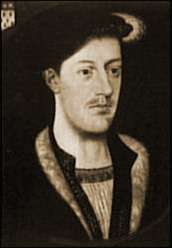Francis Weston
| Sir Francis Weston KB | |
|---|---|
 Portrait believed to be of Sir Francis Weston, by unknown artist.[1] | |
| Born | c. 1511 |
| Died |
17 May 1536 (aged 24–25) Tower Hill, London |
| Cause of death | Decapitation |
| Resting place |
Tower of London, London, United Kingdom 51°30′31″N 0°04′37″W / 51.508611°N 0.076944°W |
| Occupation | Gentleman of the Privy Chamber to Henry VIII |
| Spouse(s) | Anne Pickering |
| Children | Henry |
| Parent(s) |
Sir Richard Weston Anne Sandys |
Sir Francis Weston KB (1511[2][3] – 17 May 1536) was a gentleman of the Privy Chamber at the court of King Henry VIII of England. He became a friend of Henry VIII and was accused of high treason and adultery with Anne Boleyn, the king's second wife. Weston was condemned to death, together with George Boleyn, Viscount Rochford, Henry Norris, William Brereton and Mark Smeaton. They were all executed on 17 May 1536, two days before the Queen.
Background
Francis was the only son of Sir Richard Weston of Ufton Court in Berkshire and Sutton Place near Mayford in Surrey[4] and Anne, the daughter of Oliver Sandys of Shere at Dorking in Surrey. In 1526, aged only fifteen, he is listed as a page at court. Although he was twenty years younger than the King, he quickly became a minor member of the King's circle, listed as beating Henry at bowls, tennis, dice and other games.[2] In 1532, he was made a Gentleman of the Privy Chamber, giving him frequent access to the King. Other honours followed, including becoming a Knight of the Bath at the coronation of Anne Boleyn in 1533.[5]
In 1530, he married Anne Pickering, daughter to Sir Christopher Pickering of Killington, Cumberland and by her had a son named Henry, born in 1535. An oak marriage chest with carved heads of Francis and Anne is preserved in Saffron Walden museum, Essex.[6]
Arrest
Once arrested, Anne Boleyn was attended by four unsympathetic ladies, who had been instructed by the King's chief minister Thomas Cromwell to report on the Queen's actions. Anne told one of these ladies, Mrs. Coffin, that she had reprimanded Weston for flirting with Madge Shelton, who was betrothed to Henry Norris. Anne wondered aloud to Weston why Norris had not married Shelton yet. Weston replied, "[Norris] came more to her [Anne's] chamber for her than for Madge."[7]
Execution
Francis was executed at the age of twenty-five after being accused of committing adultery with Queen Anne Boleyn, treason and plotting to kill the king.[8] There is no evidence to support either of these accusations. Although a myth has arisen in the last twenty years that the men were accused of buggery as well as treason this is unlikely to be true.[6] This myth has arisen solely due to the unsubstantiated theories of Retha Warnicke in her 1989 biography of Anne Boleyn. None of the men were charged with buggery and there were no extant rumours of homosexuality relating to any of them. Francis was beheaded on Tower Hill, just outside the Tower of London, on 17 May 1536 along with his co-accused, George Boleyn, Viscount Rochford, William Brereton, Henry Norris and Mark Smeaton.[9]
References
- ↑ The escutcheon in the top left corner shows the Weston arms: Ermine, on a chief azure 5 bezants and the canvas bears the inscription "Weston Esq. of Sutton, Surrey". Collection of Parham Park, Sussex
- 1 2 Hughes 2004.
- ↑ Lindsey 1995, p. xviii.
- ↑ Ford 2010.
- ↑ Shaw I 1906, p. 149.
- 1 2 Ridgway 2012, p. 101–102.
- ↑ Ives 2005, pp. 334–335.
- ↑ A schedule of the charges against all five accused men are in the Baga de Secretis which can be found in Wriothesley's Chronicle I, pp. 189–226
- ↑ Wriothesley I 1875, p. 39–40.
Bibliography
- Cavendish, George (1825). Singer, Samuel Weller, ed. The Life of Cardinal Wolsey. I. By George Cavendish, His Gentleman Usher, and Metrical Visions. London: Harding, Triphook, and Lepard.
- Clarke, Ernest (1899). "Weston, Sir Francis (1511?–1536)". In Lee, Sidney. Dictionary of National Biography. 60. London: Smith, Elder & Co. pp. 360–361.
- Ford, David Nash (2010). "Sir Richard Weston (1465–1541)". David Nash Ford's Royal Berkshire History. Berkshirehistory.com. Retrieved 13 October 2013.
- Friedmann, Paul (2014). Anne Boleyn. Chalford: Amberley. ISBN 9781445617619.
- Hughes, Jonathan (2004). "Weston, Sir Francis (1511–1536)". Oxford Dictionary of National Biography (online ed.). Oxford University Press. doi:10.1093/ref:odnb/29121. (Subscription or UK public library membership required.)
- Ives, Eric (2005). The Life and Death of Anne Boleyn: 'The Most Happy'. Oxford: Blackwell. ISBN 978-0-631-23479-1.
- Lindsey, Karen (1996). Divorced, Beheaded, Survived: A Feminist Reinterpretation of the Wives of Henry VIII (revised ed.). Cambridge: Perseus Books Group. ISBN 9780201408232.
- Ridgway, Claire (2012). The Fall of Anne Boleyn. MadeGlobal Publishing. ISBN 978-1475266122.
- Shaw, William A. (1906). The Knights of England. I. London: Sherrat and Hughes.
- Warnicke, Retha M. (1989). The Rise and Fall of Anne Boleyn: Family Politics at the Court of Henry VIII. Cambridge University Press.
- Weir, Alison (2009). The Lady in the Tower: The Fall of Anne Boleyn. Jonathan Cape.
- Wriothesley, Charles (1875). Hamilton, William Douglas, ed. A Chronicle of England During the Reigns of the Tudors, From A.D. 1485 to 1559. I. Printed for the Camden Society.
